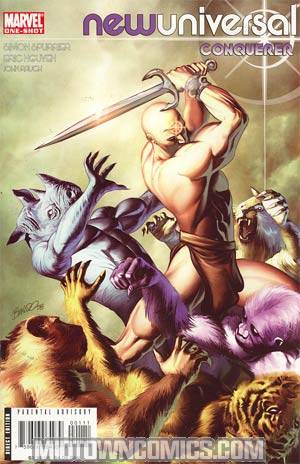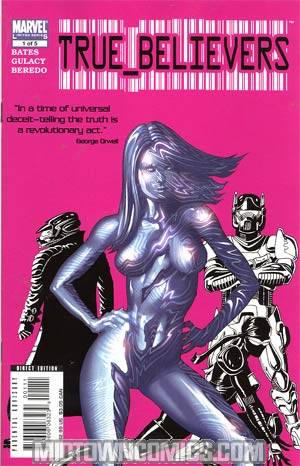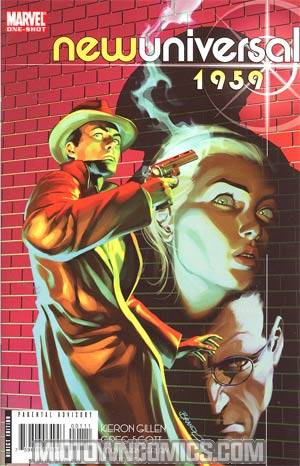DC Universe: Last Will and Testament was advertised as a Final Crisis ‘tie-in’. It wasn’t given the official Final Crisis label because it contributes nothing to the story as a whole, but was instead meant as a character study – how are various heroes of the DC Universe reacting as the world goes to hell and the Anti-Life Equation is released. Unfortunately, it’s as though no one clued Meltzer in to what was actually happening in Final Crisis, giving us some odd beats, like Wonder Woman, Batman, Superman, Wally West, and Hal Jordan out and about, spending time with their family. Superman is the only one of these characters who this could legitimately be happening with for the continuity nerds, but even so, his beats ring false.
If you’re a Meltzer fan, then I’m sure you’ll enjoy it, as it fits in well with the general tone of his work. It’s very much in the vein of most of his work, up to and including completely jobbing to Deathstroke. If, however, you’re like me and have disliked most, if not all, of Meltzer’s comics work, then avoid this – like Requiem, it contributes nothing worthwhile to the Final Crisis narrative, and like Requiem, it wouldn’t be that good, even if it did.
Grade: C
Final Crisis: Legion of Three Worlds is, reportedly, one of two minis Morrison reportedly requested to have written. After the first issue, though, you wouldn’t know it – it seems more a sequel to everything Johns has been writing in the last couple years. Pet villain? Check. Pet version of the Legion? Check. It’s a sequel to his Superman and the Legion run on Action, or so it seems, building on that particular Legion setting.
For all that the above paragraph may not make it sound appealing, especially if you find Prime overrated (which I do), or am getting sick of Johns’ disregard of anything written in the last decade (which I do), Legion of Three Worlds is a generally enjoyable experience. He makes sure that there’s a LOT of exposition for those who are less than familiar with the Legion, and it’s done in a humorous enough way that you don’t really mind – you’ll laugh at how history now views Prime, I guarantee it – and he quickly sets the book up. After only a single issue, you know who the villains are, and the other two Legions are already being brought in, meaning that the action can really begin next issue.
The issue has almost no action, but the set-up is entertaining. I’m waiting to see how this ties into Final Crisis – I have my ideas, but a review is no place for those. It’s a fun issue that might bring some fans to the Legion…but which Legion?
Grade: B+
Rogues’ Revenge is rather completely different than Legion of Three Worlds – its clearly ties into Final Crisis, and like most great tie-ins, tells its own story using elements of the overarching events. This book is also different in that it’s pretty action-packed – and as you can imagine from a group of supervillains on a vengeance crusade, it’s pretty damn violent, too.
Still, the Rogues might be Johns’ greatest characters, and his characterization comes out well here. The Rogues work well together, and Rogues’ Revenge demonstrates pretty well the strengths of the team. They have rules. They trust each other. And they aren’t afraid to fight to protect each other – and to protect their reputations.
FC: RR #2 is a violent exploration of the Rogues bond, but it also gives a little more insight about the situation with Inertia and Zoom, and its that plot that ties it into Final Crisis the most, and in the most interesting way. Libra knows that the Flash can cause problems, especially in a time of Crisis, and Libra, Zoom, and the Rogues are all part of his plan to take the Flash down. Rogues’ Revenge #2 is a quick, exciting read that leaves me eager for more.
Grade: A-
Final Crisis: Superman Beyond is one of the main minis of the series. Written by Morrison himself, it doesn’t take too much time – the entire mini takes place between the last two heartbeats of Lois Lane – but believe me when I say that, content-wise, this single issue is almost as dense as the first three issues of Final Crisis, containing references to Morrison’s legendary Animal Man run, the origins of the Monitors, and the first reveal of the Big Baddie of Final Crisis, a darkness beyond even Darkseid.
Content-wise, Superman Beyond is an interesting, dense title. But one of the things it’s gotten notice for is the fact that it’s in 3D, and comes with a pair of 3D glasses. How did that work out? Shockingly well, actually. The first time I read through the issue, I honestly didn’t like it – I had the glasses on the whole time. This is the wrong way to do it. You should only put the glasses on for the 3D pages, or you risk ruining Mahnke’s excellent art.
The first two 3D pages really don’t work out for me – I found them cluttered, and it’s a full half-book before we get to the next ones, but when we do, they are SPECTACULAR. They 3D pages for the remainder of the book are well-chosen and well-executed, and they really do add a little something special to the book. Art and story-wise, Final Crisis: Superman Beyond #1 is an interesting, memorable ride – I can’t wait for the next issue.
Grade: A
It’s no secret by now that I’m a little bit of a NewUniversal fanboy. The original mini was great, and 1959 was even better, but I was a little bit wary of this one, because as cool as super-vikings are conceptually, one of my favorite part of NewUniversal was how contained it was, how every issue genuinely contributed something interesting to the setting as a whole. If you’re a NewUniversal fan, though, don’t worry – NewUniversal: Conqueror contributes a good bit to the setting, and it does so in an interesting way.
We first learned about the reign of Starr the Slayer, one of the oldest Starbrand’s around, early in NewUniversal, about the invincible empire of high-tech he forged way back when. Here, we see Starr’s empire collapsing thanks to a traitor within. The story is entertaining, though predictable, and Spurrier’s insane fantasy warrior speak is frequently hilarious. Conqueror is fun and interesting, and like 1959, it’s an excellent companion piece to the main NewUniversal titles.
Also, as a note, what other comic around offers the origins of the, and I quote, ‘self-trysting engine’. That is awesome.
Grade: A-







